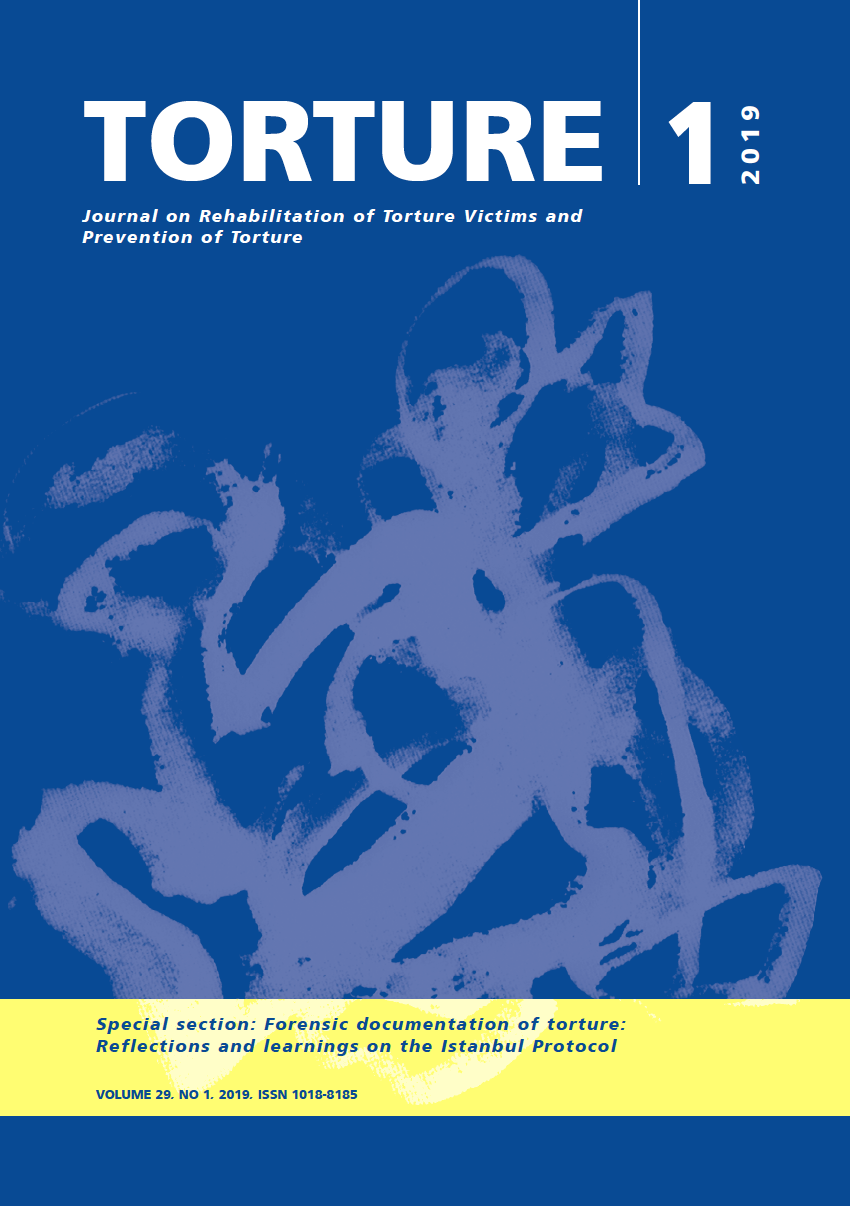The medico-legal assessment of asylum seeker victims in Italy
DOI:
https://doi.org/10.7146/torture.v29i1.111067Palabras clave:
humanitarian medicine, clinical forensic medicine, torture victims, torture survivors, asylum seekers, medico-legal assessment, Istanbul protocolResumen
Introduction: Changing patterns of migration hasrequired states andgovernments to respond to the specific medical and legal needs of asylum seekers. Based on medical assessments undertaken at the University Institute of Legal Medicine, the present study aims to describe the cases of asylum applicants who have suffered from physical violence, including torture, and the variables involved. Methods: Over a 10-year period, 225 survivors were examined by clinical forensic professionals from the University Institute of Legal Medicine. Results:85% of asylum applicants came from Africa, 87% were male, and the most common age group was 26-40 years old. 46% of applicants fled their country for political reasons. Blunt force injuries were reported in 45% of cases, the trunk was the most affected area of the body (40%), and applicants presented with an average of two different mechanisms of lesions and an average of four lesions each. Discussion/conclusion:Assessment of physical violence on asylum seekers requires the cooperation of professionals with different skillsets and training.
Citas
Afana, A. H. (2009). Weeping in silence: the secret sham of torture among Palestinian children. Torture Journal, 19(2), 167-175.
Arge, S. O., Hansen, S. H., & Lynnerup, N. (2014). Forensic odontological examinations of alleged torture victims at the University of Copenhagen 1997-2011. Torture Journal, 24(1), 17-24.
Asgary, R., Charpentier, B., & Burnett, D. C. (2013). Socio-medical challenges of asylum seekers prior and after coming to the US. Journal of immigrant and minority health, 15(5), 961-968. doi: 10.1007/s10903-012-9687-2.
Bhugara D. (2004). Migration and mental health. Acta Psychiatrica Scandinavica, 109, 243–258.
Castagna, P., Ricciardelli, R., Piazza, F., Mattutino, G., Pattarino, B., Canavese, A., & Gino, S. (2018). Violence against African migrant women living in Turin: clinical and forensic evaluation. International journal of legal medicine, 132(4), 1197-1204. doi: 10.1007/s00414-017-1769-1.
Clément, R., Lebossé, D., Barrios, L., & Rodat, O. (2017). Asylum seekers alleging torture in their countries: Evaluation of a French center. Journal of forensic and legal medicine, 46, 24-29. doi: 10.1016/j.jflm.2016.12.011.
den Otter, J. J., Smit, Y., dela Cruz, L. B., Özkalipci, Ö., & Oral, R. (2013). Documentation of torture and cruel, inhuman or degrading treatment of children: A review of existing guidelines and tools. Forensic science international, 224(1-3), 27-32. doi: 10.1016/j.forsciint.2012.11.003.
Edston, E., & Olsson, C. (2007). Female victims of torture. Journal of Forensic and legal medicine, 14(6), 368-373. doi: 10.1016/j.jflm.2006.12.014
Franceschetti, L., Magli, F., Merelli, V., Muccino, E., Amadasi, A., & Cattaneo, C. (2017). The medico-legal evaluation effect: asylum grant rate in the metropolitan city of Milan. La Revue de Médecine Légale, 8(4), 186.
Franceschetti, L., Magli, F., Merelli, V. G., Muccino, E. A., Gentilomo, A., Agazzi, F., ... & Cattaneo, C. (2019). The effect of the medico-legal evaluation on asylum seekers in the Metropolitan City of Milan, Italy: a pilot study. International journal of legal medicine, 133(2), 669-675. doi: 10.1007/s00414-018-1867-8.
Fuentes‐Duculan, J., Bonifacio, K. M., Suárez‐Fariñas, M., Kunjravia, N., Garcet, S., Cruz, T., ... & Tirgan, M. H. (2017). Aberrant connective tissue differentiation towards cartilage and bone underlies human keloids in African Americans. Experimental dermatology, 26(8), 721-727. doi: 10.1111/exd.13271.
Ghaleb, S. S., Elshabrawy, E. M., Elkaradawy, M. H., & Welson, N. N. (2014). Retrospective study of positive physical torture cases in Cairo (2009 &2010). Journal of forensic and legal medicine, 24, 37-45. doi: 10.1016/j.jflm.2014.03.005.
Guy, K. M. (2009). Child soldiers as zones of violence in The Democratic Republic of Congo: three cases of medico-legal evidence of torture. Torture Journal, 19(2), 137-144.
Kinyanda, E., Musisi, S., Biryabarema, C., Ezati, I., Oboke, H., Ojiambo-Ochieng, R., ... & Walugembe, J. (2010). War related sexual violence and it's medical and psychological consequences as seen in Kitgum, Northern Uganda: A cross-sectional study. BMC International Health and Human Rights, 10(1), 28.
Leth, P. M., & Banner, J. (2005). Forensic medical examination of refugees who claim to have been tortured. The American journal of forensic medicine and pathology, 26(2), 125-130.
Masmas, T. N., Student, E. M. M., Buhmann, C., Bunch, V., Jensen, J. H., Hansen, T. N., ... & Student, J. S. M. (2008). Asylum seekers in Denmark. Torture Journal, 18(2), 77-86.
Mladovsky, P., Ingleby, D., & Rechel, B. (2012). Good practices in migrant health: the European experience. Clinical medicine, 12(3), 248-252.
Moisander, P. A., & Edston, E. (2003). Torture and its sequel—a comparison between victims from six countries. Forensic science international, 137(2-3), 133-140.
Moreno, A., Crosby, S., Xenakis, S., & Iacopino, V. (2015). Implementing Istanbul Protocol standards for forensic evidence of torture in Kyrgyzstan. Journal of forensic and legal medicine, 30, 39-42. doi: 10.1016/j.jflm.2014.12.009
Peart, J. M., Tracey, E. H., & Lipoff, J. B. (2016). The role of physicians in asylum evaluation: documenting torture and trauma. JAMA internal medicine, 176(3), 417-417.
Rechel B, Mladovsky P, Devillé W, Rijks B, Petrova-Benedict R, McKee M (Ed.) (2011). Migration and health in the European Union. Open University Press.
Sheather J, Beynon R, Davies T, Abbasi K (2015) Torture and doctors’ dual obligation – Health professionals need support to put the wellbeing of detainees first. BMJ. 350-589. doi: 10.1136/bmj.h589.
Thomsen, J. L. (2000). The role of the pathologist in human rights abuses. Journal of clinical pathology, 53(8), 569-572.
World Health Organization. (2010). How health systems can address health inequities linked to migration and ethnicity. Copenhagen: WHO Regional Office for Europe.
Descargas
Publicado
Cómo citar
Número
Sección
Licencia
We accept that some authors (e.g. government employees in some countries) are unable to transfer copyright. The Creative Commons Licence Attribution-NonCommercial-NoDerivatives 4.0 International (CC BY-NC-ND 4.0) covers both the Torture Journal and the IRCT web site. The publisher will not put any limitation on the personal freedom of the author to use material contained in the paper in other works which may be published, provided that acknowledgement is made to the original place of publication.


